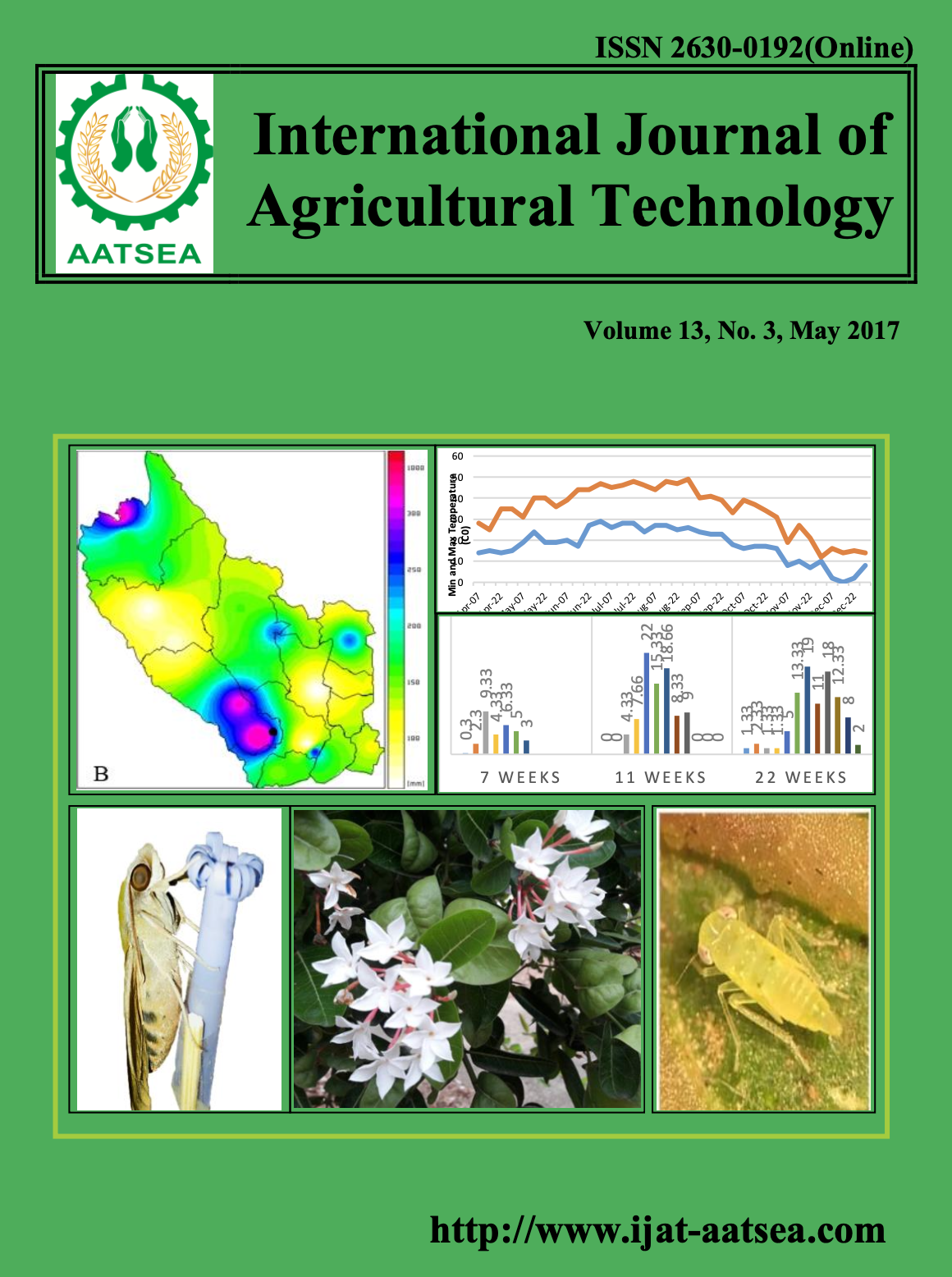Impact of plant growth regulators on the growth and yield of cotton
Main Article Content
Abstract
The experiment was carried out in a three replicated randomized complete block design, having net plot size of 6 x 8 m = (48 m2), during the year 2013-14 at the experimental fields of Cotton Section, Agriculture Research Institute, Tandojam. The treatments are comprised such as control or un-treated plots, Planofix at 50 ml/500 litres of water at bud formation, Planofix at 100 ml/500 litres of water at bud formation, Planofix at 150 ml/500 litres of water at bud formation, Pix at 500 ml/500 litres of water at bud formation, Pix at 1000 ml/500 litres of water at bud formation, Pix at 1500 ml/500 litres of water at bud formation.Theobersation were recorded on parameters of economic importance such as plant height (cm) Monopodial branches per plant, Sympodial branches per plant, Opened bolls per plant, Un-opened bolls per plant, Seed cotton weight per plant (g), Seed cotton yield (kg ha-1), Ginning out-turn G.O.T. (%). All the growth and yield character of cotton variety of sindh-1 was significantly at (P<0.05) affected by various plant growth regulators. The maximum plant height (137 cm), monopodial branches per plant (1.9), symonopodial branches per plant (23.0), opened bolls per plant (30.1), un-opened bolls per plant (4.0), seed cotton yield per plant (97.4 g), seed cotton yield (3074.0kgha-1) and G.O.T (34.5%) were observed underPix at 1000 ml/500 litres of water at bud formation. It is concluded from studies that all the characters of cotton variety sindh-1 was significant at 5% probability level except G.O.T % which was non-significant Plant growth hormones are effective for enhancing the yield of cotton crop.Pix at 1500 ml/500 litres of water at bud formationis more effective for obtaining more number of bolls per plant and maximum seed cotton yield per plotsas well as seed cotton yield kg ha-1.
Article Details

This work is licensed under a Creative Commons Attribution-NonCommercial-NoDerivatives 4.0 International License.
References
Abro, G. H., Syed, T. S., Unar, M. A. and Zhang, M. S. (2004). Effect of a plant growth regulator and micronutrients on insect pest infestation and yield components of cotton. Journal of Entomology 1:12-16.
Ahmed, A. U. H., Ali, R., Zamir, S. I. and Mehmood, N. (2009). Growth, yield and quality performance of cotton cultivar BH-160 (Gossypium hirsutum L.). Journal of Animal and Plant Science 19:189-192.
Akhtar, K. P., Ullah, R., Khan, I. A., Saeed, M., Sarwar, N. and Mansoor, S. (2013). First symptomatic evidence of infection of Gossypium arboreum with cotton leaf curl burewala virus through grafting. International Journal of Agricultural Biology 15:157-160.
Anonymous (2014). Economic survey of Pakistan 2013-2014. Ministry of Food and Agriculture, Finance Division, Economic Advisor Wing, Islamabad, Pakistan.
APTMA. (2012). World Cotton and non-Cotton Fiber Consumption.
Biles, S. P. and Cothren, J.T. (2001). Flowering and yield response of cotton to application of mepiquat chloride and PGR-IV. Crop Science 41:1834-1837.
Derrick, M., Oosterhuis and Duli, Z. (2000). Field evaluation of plant growth regulators. Proceedings of the 2000 Cotton Research Meeting.
Gencsoylu, I. (2009). Efect of plant growth regulators on agronomic characteristics, lint quality, pests, and predators in Cotton. Journal of Plant Growth Regulator 28:147-153.
Gomez, K. A. and Gomez, A. A. (1984). Statistical Procedures for Agricultural Research. Second edition. A Wiley-Interscience Publication John Wiley and Sons. 690 pp.
Heilman, M. D. (1985). Effect of mepiquat chloride and nitrogen levels on yield, growth characteristics and elemental composition of cotton. Journal Plant Growth Regulator 4:41-47.
ICAC (2012). Country Report: Pakistan at the 71st plenary meeting of the international cotton advisory committee (ICAC), Interlaken, Switzerland.
Kiran Kumar, K. A. (2001). Effect of plant growth regulators on morphophysiological traits and yield attributes in hybrid cotton (Gossypium hirsutum L.). (Master’s Thesis). University of Agricultural Sciences, Dharwad, India.
Muhammad, I., Khezir, K. and I. Noor. (2007). Growth response of cotton to plant growth regulators. Asian Journal Plant Science 6:87-92.
Nichols, S. P., Snipes, C. E. and Jones, M. A. (2003). Evaluation of row spacing and mepiquat chloride in cotton. Journal Cotton Science 7:148-155.
Nuti, R. C., Viator, R. P., Casteel, S. N., Edmisten, K. L. and Wells, R. (2006). Effect of planting date, mepiquat chloride, and glyphosate application to glyphosate-resistant cotton. Agronomy Journal 98:1627-1633.
O’Berry, N. B., Faircloth, J. C., Jones, M. A., Herbert Jr., D. A., Abaye, A. O., McKemie, T. E. and Brownie, C. (2009). Differential responses of cotton cultivars when applying mepiquat pentaborate. Agronomy Journal 101:25-31.
Ram Prakash and Mangal Prasad. (2000). Effect of nitrogen, chloromequate chloride and farmyard manure applied to cotton (G. hirsutum) and their residual effect on succeeding wheat (Triticum aestivum) crop. Indian Journal of Agronomy 45:263-268.
Souza, F. and Rosolem, C. (2007). Response of cotton plant to growth hormones/plant growth regulators. Science Agriculture 64:125-130.
Wilson, D. G. Jr., York, A. C. and Edmisten, K. L. (2007). Narrow-row cotton response to mepiquat chloride. Journal of Cotton Science 11:177-185.
Zakaria, M., Sawan, M. and Amal, H. E. (2006). Response of yield, yield component and fiber properties of Egyptian cotton (Gssypium barbadense L.) to nitrogen fertilization and foliar applied potassium and mepiquat chloride. The Journal of Cotton Science 10:224-234.


